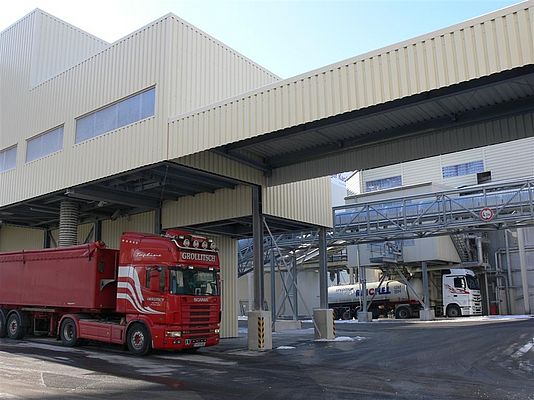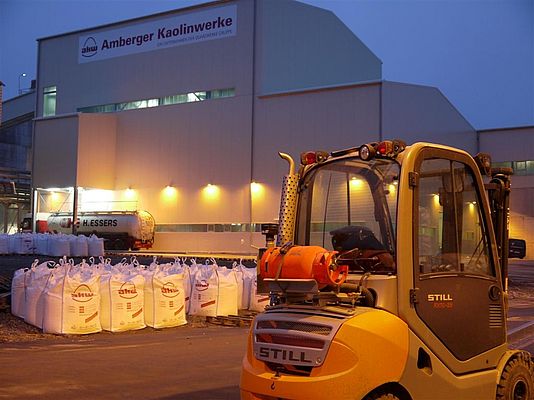Process control at Amberger Kaolinwerke happens on two levels: One level shows the entire process including all individual production steps in an abstract way and the other level implements these specifications via PLC control, sensor and actuator technology.
The Amberger Kaolinwerke Eduard Kick GmbH & Co. KG (AKW), part of the Quarzwerke Group, based in Hirschau, Germany, has specialised in the quarrying of Kaolin, but also for silica sand and feldspars, and refines these minerals for industrial use. Kaolin is a soft white malleable mineral which consists mainly of finely grained, plate-like particles and is used primarily in paper and porcelain manufacturing. Because of its whiteness and plasticity Kaolin is particularly well suited for use as a filler or extender, as a ceramic and fire-proof raw material or as a pigment.
On a very large and extensive production site the raw soil is separated in different parts of the plant into the three pure industrial mineral types, and is then processed or refined in various wet-mechanical processing steps, such as sieving, filtering, cleaning or mixing. For more than a decade the smooth running of production has been ensured by process control technology and production log solutions provided by Zoz & Partner GmbH.
Separating planning and execution levels
The result is a process-oriented, formula-controlled mixing control system with standardised interface at the control level that could be applied in many areas of the processing industry. The mixing control system has grown over the years in line with the requirements of the production plant itself.
Freddy Schlosser, Head of Development at Zoz & Partner GmbH, sums up his experiences: “Practice has shown that the most difficult part is to convince the customer of the benefits of a process control technology with a rigorous distribution of responsibilities. This separation effectively means that within project management, orders are defined at management levels which represent recurring tasks in an abstracted way. These specifications are initially completely independent of the technology that is executing the task. It does not matter to the model whether the order is performed manually or in automated fashion, and if automated, which control is being used.
The specifics of these orders are then transmitted to the control level via a uniformly defined, logical interface, which has to implement these specifications technically, for example with a PLC control that triggers the respective pumps and valves so as to mix the desired quantities from predefined sources. A significant advantage of the rigorous separation is that each area is able to concentrate on its core competences.
The system grows with its tasks
As in every extensive plant in the processing industry, Amberger Kaolinwerke had some plant sections or production lines converted or updated over the years. In connection with these the mixing control system is also always being integrated for the planning of mixing orders and for the coordination of manufacturing processes.
“Obviously not every plant section performs the exact same tasks as the other sections, so we have also gradually added new components to our software”, explains Mr. Schlosser. An important point that has been added recently is the automated data capture and linking of more and more areas into the overriding ERP system. The simple integration into the existing automation environments is possible thanks to standardised OPC interfaces.
Managing process data reliably
Over the years there have also been expansions in the area of data storage. The system records and archives process-relevant data for quality assurance, traceability or process optimisation purposes, in addition it also fulfils new and growing demands, for example due to environmental regulations, which were put on the mixing control system.
A new barcode system introduced to the plant prevents misunderstandings. This way the batch to be dispatched can be allocated to the right truck. “With the barcode solution we are taking an important step towards a fully automated production, 24 hours a day, seven days a week” says Freddy Schlosser.
Flexible adjustability
The goal to be achieved was a mixing control system, that can be used in different plant sections at the Hirschau location, and that was flexible enough to adjust to different work flows and plant configurations, without outside help. Bernhard Neudecker, M.Eng, Head of Production at Amberger Kaolinwerke, outlines the benefits: “For us the clear advantage lies in the separation between operational processes and the implementation at the control level. The modeller enables us to set up new processes with flexibility, but without any programming effort. At the same time the mixing control system can easily and universally be used in the various plant sections at our production premises. “
But there is hardly any need for this, as Mr. Neudecker attests: “We need practically no assistance with the running system and should there be an exception to this rule we are able to - thanks to the remote access - quickly and without expensive travel, solve the problem. The staff of Zoz & Partner literally only come by in case of commissioning or to discuss new tasks. We are extremely satisfied, not only with the mixing control system itself, but also with the after-sales service. This is, after all, mirrored in our cooperation which goes back more than a decade. “
Process control in Kaolin refining
with distributed responsibilities
- by Zoz & Partner GmbH
- September 5, 2011
- 457 views


















